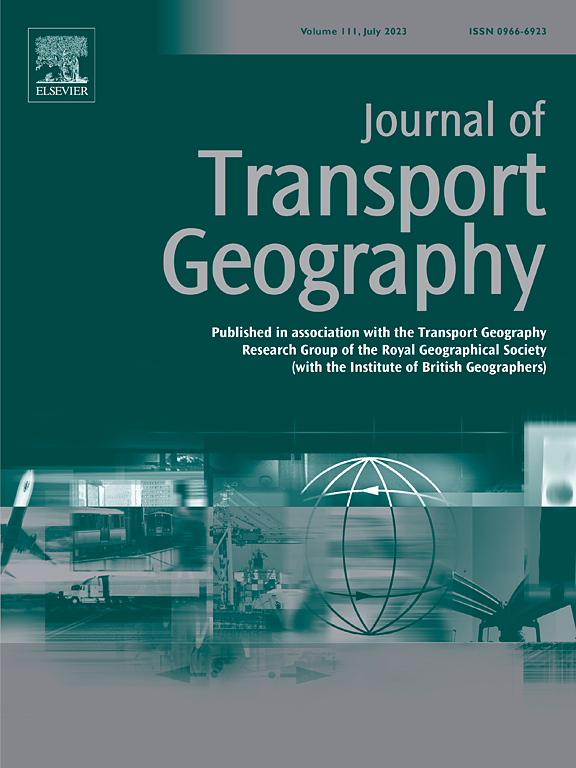Machine Learning driven complex network analysis of transport systems
IF 6.3
2区 工程技术
Q1 ECONOMICS
引用次数: 0
Abstract
A complex network is a system of interconnected nodes linked by edges, exhibiting non-trivial structural features such as community structure or scale-free distributions. This study develops a novel and generic Machine Learning-driven framework that integrates Complex Network Theory and Machine Learning methods for a comprehensive and multifaceted analysis of transport systems. Specifically, four key functional development and analysis are undertaken: 1) Network analysis, using complex network indicators to study the static properties of the transport systems; 2) Network clustering, employing K-means and hierarchical clustering methods to identify underlying community structures; 3) Network resilience, examining the networks' dynamic characteristics and structural evolution under escalating node attacks to evaluate their robustness; 4) Link and feature prediction, developing Graph Convolutional Networks (GCNs) and Multi-Layer Perceptron (MLP) models to predict hidden links and features. The proposed framework is subsequently applied to two distinct transport systems, namely, the China railway network and the Paris multi-modal transport system. The complex network analysis reveals distinct complex network features in network scale, density, and efficiency, yet both demonstrate a power-law distribution. The clustering analysis based on various node and edge properties exhibits a pattern of concentric circles, radiating outward from the urban to peripheral cities in China railway network, while a high density of short-distance connections within central Paris and a prevalence of long-distance connections in the outskirts. The network attack simulations show fine resilience of the Parisian multi-modal system and low resilience of the China railway network. For link prediction, an encoder-decoder model based on GCN and multiple MLPs are developed for various scenarios. The results for the China railway network reveal critical interregional links, emphasizing the need to strengthen regional connectivity, such as expanding the high-speed railway between Hainan Island and the mainland, and establishing a major transportation artery running from south to north. In the Paris transport system, this study predicts an interesting link extending from southern Paris eastward toward northern Seine-et-Marne, indicating a demand for a direct connection. For both networks, the hidden links are largely concentrated in more developed areas, likely driven by strong economic and social interaction demands, highlighting the need for more balanced transport network development. Overall, the results of this study align closely with existing literature and official transport development plans. This research contributes to the theoretical development in Complex Network Analysis using Machine Learning and offers valuable insight to improve the two transport systems.
机器学习驱动的运输系统复杂网络分析
一个复杂的网络是一个由边缘连接的相互连接的节点系统,表现出非平凡的结构特征,如群落结构或无标度分布。本研究开发了一种新的通用机器学习驱动框架,该框架集成了复杂网络理论和机器学习方法,用于对运输系统进行全面和多方面的分析。具体来说,进行了四个关键的功能开发和分析:1)网络分析,使用复杂的网络指标来研究运输系统的静态特性;2)网络聚类,采用K-means和分层聚类方法识别底层群落结构;3)网络弹性,研究节点攻击升级下网络的动态特征和结构演化,评估网络的鲁棒性;4)链接和特征预测,开发图卷积网络(GCNs)和多层感知器(MLP)模型来预测隐藏的链接和特征。建议的框架随后应用于两个不同的运输系统,即中国铁路网和巴黎多式联运系统。复杂网络分析揭示了复杂网络在网络规模、密度和效率上的明显特征,但两者都表现为幂律分布。基于各种节点和边缘属性的聚类分析显示,中国铁路网呈现同心圆的格局,从城市向外辐射到外围城市,而巴黎市中心的短途连接密度高,郊区的长途连接普遍存在。网络攻击仿真结果表明,巴黎多式联运系统具有良好的弹性,而中国铁路网具有较低的弹性。在链路预测方面,提出了一种基于GCN和多个mlp的编码器-解码器模型。中国铁路网的结果揭示了关键的区域间联系,强调了加强区域连通性的必要性,例如扩大海南岛与大陆之间的高速铁路,建立一条从南到北的主要交通动脉。在巴黎的交通系统中,这项研究预测了一个有趣的连接,从巴黎南部向东延伸到塞纳-马恩北部,表明了对直接连接的需求。对于这两个网络来说,隐藏的链接主要集中在更发达的地区,可能是由强劲的经济和社会互动需求驱动的,这凸显了更平衡的交通网络发展的必要性。总体而言,本研究的结果与现有文献和官方交通发展计划密切相关。这一研究有助于机器学习复杂网络分析的理论发展,并为改进两种运输系统提供有价值的见解。
本文章由计算机程序翻译,如有差异,请以英文原文为准。
求助全文
约1分钟内获得全文
求助全文
来源期刊

Journal of Transport Geography
Multiple-
CiteScore
11.50
自引率
11.50%
发文量
197
期刊介绍:
A major resurgence has occurred in transport geography in the wake of political and policy changes, huge transport infrastructure projects and responses to urban traffic congestion. The Journal of Transport Geography provides a central focus for developments in this rapidly expanding sub-discipline.
 求助内容:
求助内容: 应助结果提醒方式:
应助结果提醒方式:


